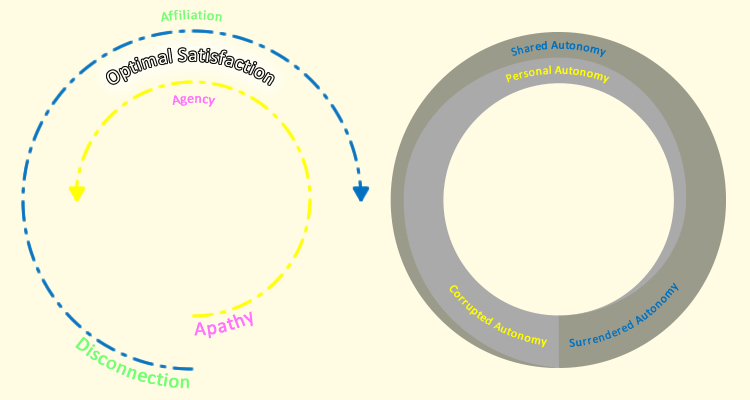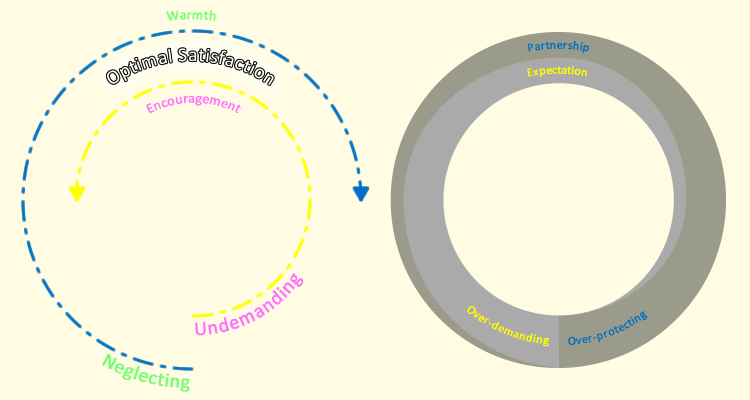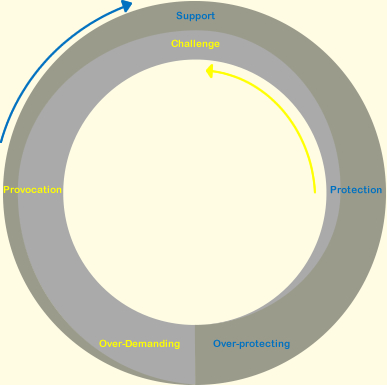Parent Background
After 15 years of working to help education staff and parents support children toward motivation and wellbeing, my conclusion is that a critical factor is the parent's secure sense of self, being comfortable in their own skin. This builds, and benefits from, the parents capacity to self-reflect. Consequently we have developed this self-reflection tool for parents.
The Inspire-ring Parent consists of 80 descriptions that profile Parenting styles. It invites parents to rate each description on how well they describe themselves on a six point scale. Descriptions rated 3 and above are displayed within the Ring. The Ring helps parents reflect on their attitude to their children by providing a framework to express what they may know intuitively about themselves but might not be able to put into words.
This is a reflection tool, not an assessment or a test.
The array of questions gives the profile a degree of impartiality. It primes parents to reflect on how they relate to their children and also to move in the right direction. The Inspire-ring gives immediate feedback in the form of a personal chart, allowing for a structured and focused discussion of key issues around how the parent sees themselves and their relationship with their children. Ideally parents should share their findings with someone they trust.
The success with which parents motivate their children is, in large part, down to how they relate to them, that is their Parenting Style. Parenting Style influences children's motivation and wellbeing by impacting on their motivating needs. The two foundational needs are Affiliation, to feel a sense of belonging and Agency, to feel a sense of progress. The third need is Autonomy, the need to be self-determining. Without compelling autonomy goals, children can be sociable and competent but aimless and purposeless. It is their autonomy goals that give children direction and motivation.
This model explores Autonomy through a new and powerful conceptualisation with two distinct strands, namely Shared Autonomy and Personal Autonomy. These two strands are represented by two interlinking spirals. When one spiral balances the other we have balanced Autonomy. The spirals form the Ring of Autonomy.
Personal Autonomy is our need to assert our individuality and achieve status. It generates self-determination and propels us to maximise our strengths and personal achievement. Personal Autonomy is grounded in and, in turn, further develops Agency. Shared Autonomy is our need to contribute to something bigger than ourselves and have a sense of shared purpose. It generates cooperation and shared goals. Shared Autonomy grows naturally out of Affiliation, the foundation that allows us to build coalitions, and, in turn, Shared Autonomy deepens our Affiliation. Affiliation and Agency are discrete needs but can be thought of as embedded within their own Autonomy spiral, as displayed in Fig 1 below.
There are two potential pitfalls with Autonomy, when the spirals becomes imbalanced. These form the underside of the Ring. When we are driven by self-interest to get what we want, this is Personal Autonomy. However if we take this too far we can become selfish and domineering. Personal Autonomy can overpower Shared Autonomy and slide into Corrupted Autonomy, where we use and impose on others for our own ends. The dark side to Shared Autonomy is when we become undermined by too much accommodation to others, leading to blind acquiescence or Surrendered Autonomy.

The Inspire-ring maps out the main ways parents meet their children's needs. These are the 'energising principles'. These principles and their darker undersides are presented in fig 2 below.

Warmth and Partnership offer the children Support. Encouragement and Expectation provide Challenge.
The Inspire-Ring aims to help parents reflect on how they balance Support and Challenge. After completing the Inspire-Ring, a parent's point on the ring represents how she or he resolves the tension between Support and Challenge. Each parent's resolution can be adaptive or can become imbalanced in one of two directions, either towards being 'over-demanding' or 'over-protecting', as displayed in Fig 3 below. Provocation and protection are watershed points in either direction. We can provoke to get a reaction either for better or for worse and we can protect children to help meet their needs or to meet our own needs. A point on the Ring below these watersheds is an indication of a slide towards a negative impact on self and children.

The Ring can be sub-divided into sections representing the Parenting Styles, as displayed in Fig 4 below.
The Hugging style priorities Support over Challenge. The Squeezing style prioritises Challenge over Support.
The Inspiring style optimally blends Support and Challenge, drawing children near to them and promoting interdependence, whilst at the same time making demands on them in a way that helps them to feel proud of their progress. Inspirers get the balance right; they are not only strict and demanding but also warm and friendly; they are “warm demanders”.
If a parent is having a ‘bad day’, their defensive style will be the excess of their ‘good day’ style.
- Posing - displays their expertise rather than building it in their children.
- Pleasing -tries too hard to please and may be indecisive.
- Bruising - overly provocative with low levels of Support.
- Smothering- over-protective and unable to direct children appropriately.
- Resenting- shows indifference and lacks Warmth and Partnership.
- Fearing- devoid of Encouragement and Expectation and at risk of putting children off.
- Humiliating- can be the smothering 'pushover who eventually snaps and loses control, or in a more calculated way, it can happen when the Bruising parent goes too far.
